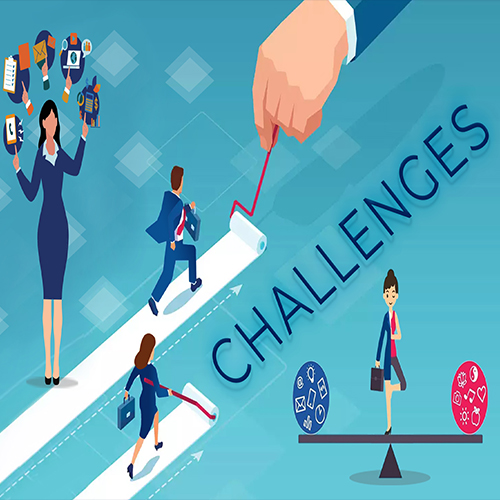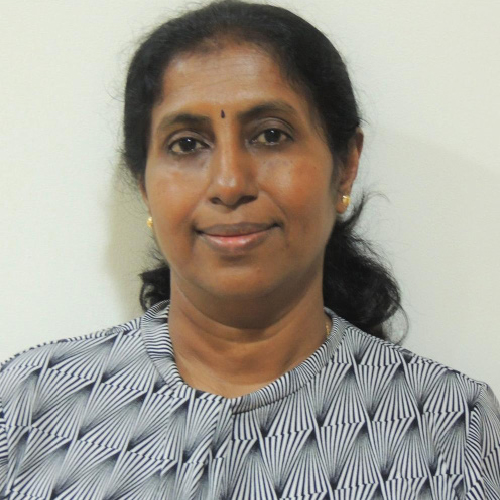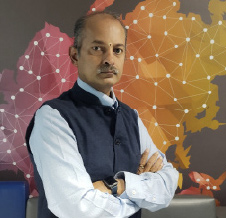
We talk about women rights and their independence, equality among man and women in every aspect of life but is it followed in actual sense? One can find various instances of inequality between a man and women in life and it is significantly visible in the professional front across industries. Women faces various challenges while climbing the growth ladder in their career.
A woman faces various challenges like gender bias leading to pay disparities, stereotypes, balancing work and family, unequal opportunities, imposter syndrome etc. It is also true that organizations are working towards gender equality and understanding the importance of diversity and implementing inclusive policies.
It is to be noted that though IT industry has made great progress but the women representation in the industry is insignificant. According to the Global Gender Gap Report 2023 by the World Economic Forum, as of 2023, women account for 27% of India’s STEM (Science, Technology, Engineering and Mathematics) workforce, as compared to 32% of the non-STEM workforce. The number further staggers when it come to the women representation in the leadership roles. This leads to lack of role models for the women pursuing their career in STEM.
But it is also true that women played an instrumental role in the development of the technology landscape in India for many years. Notable figures like Debjani Ghosh, NASSCOM’s first woman president in three decades, and Ritu Karidhar, recognized as the 'Rocket woman of India' for her contribution as Director of the Chandrayaan-2 mission, Mangala Mani, ISRO’s first woman scientist to spend over a year in Antarctica, exemplify the significant impact of Indian women in the IT sector. Also, Sudha Murthy, whose early career struggles underscore the paradigm shift toward a more inclusive culture in the IT sector.
This highlights the fact that more women representation in leadership roles are required so that more women get inspired to pursue their career in STEM.
Mentorship and sponsorship programs are important for career development of women
 Anita Kukreja
Anita Kukreja
Head - Marketing and Channel Sales, IceWarp India
Despite strides in increasing women's presence in technology, challenges persist, including gender bias leading to pay disparities. Women in the industry often find themselves fighting stereotypes, and their contributions are sometimes taken for granted. Balancing work and family, unequal opportunities, and imposter syndrome further add to these hurdles. These issues demand ongoing efforts to foster inclusivity and provide equal opportunities, ensuring women not only break stereotypes but also receive due recognition and fair compensation in the tech industry.
In spite of ongoing challenges, the technology sector is making positive strides towards gender equality. Organizations are increasingly recognizing the importance of diversity and implementing inclusive policies. Mentorship programs and female role models are emerging, providing support for women in tech. Efforts to boost women in leadership roles are gaining traction, fostering a more representative industry. Companies are addressing workplace culture issues through awareness and diversity training. Flexible work arrangements are also helping individuals balance work and family responsibilities. While challenges persist, these positive initiatives are shaping a more inclusive and equitable future for women in technology.
To foster increased women participation in the technology workforce, organizations can implement several key initiatives. First and foremost, establishing mentorship and sponsorship programs can provide crucial support for women in their career development. Offering flexible work arrangements and promoting a healthy work-life balance is essential to accommodate diverse needs. Companies should actively work towards eliminating gender biases in hiring and promotions through standardized processes. Providing training on diversity and inclusion, as well as creating affinity groups, helps build a supportive community within the organization. Publicly committing to gender diversity goals and regularly measuring progress can hold organizations accountable and drive continuous improvement. By fostering an inclusive and equitable workplace, organizations can encourage more women to pursue and thrive in technology roles.
Perseverance is the key to success in STEM
 Sudha KV
Sudha KV
Vice President, Dell Technologies India
STEM, or technology at large is an extremely fun and creative industry. As technology continues to take center stage across sectors, it is becoming one of the most attractive areas for youngsters today. A large number of women enter the technology workforce, and perform exceptionally well. However, they quit at the mid-level, before making it to the top. Therefore, while there is a significant representation of women in technology, the ladder to leadership levels dwindle. This leads to the leaky bucket phenomenon where very capable women professionals - after reaching a certain point in their career, drop out due to many obstacles – family responsibilities, workplace biases etc.
A passion to have a career and to trust my support systems and delegate responsibilities has been the key for me to overcome such challenges. Success in STEM demands perseverance, belief in one’s capabilities, and breaking barriers by proving competence. Also, the ability to take risks and getting out of comfort zone to pursue new opportunities has been very important.
Organizations need to be very mindful in three pillars of Talent: Hiring, Development and Retention. Employing inclusive hiring methods, such as blind resume screening and gender-neutral job descriptions, is essential to achieving workforce diversity. Providing career restart opportunities for women on career break, targeted development programs and retention initiatives are needed. Of course, Mentoring and advocacy programs should be in place.
Mentorship makes a difference to aspiring women
 Mankiran Chowhan
Mankiran Chowhan
Vice President, Salesforce India
While the endeavour to achieve gender parity in the technology sector is undoubtedly commendable, the challenges continue to exist. Despite efforts to promote diversity, preconceptions and bias do affect career progressions for women at work. Balancing family responsibilities can pose another challenge, as societal expectations and organizational structures may not always align with the diverse needs of women professionals. While it’s absolutely essential for men to share the load, it’s just as important for companies to create a supportive working environment that makes it easier for women to balance their professional and personal lives.
Due to disparities in recognition and opportunities, women frequently struggle with the desire to prove themselves more than their male counterparts. Real change in any organization starts at the top. When the board and leadership team recognize and embrace the invaluable benefits of gender diversity, the rest of the organization will follow suit.
It is imperative that organizations cultivate an inclusive culture that actively challenges prejudices, supports work-life balance policies, and encourages mentorship programmes in order to overcome these challenges. Building a future where women can prosper and fully contribute to the constantly changing tech landscape requires deliberate initiatives and constant communication.
There’s plenty of evidence suggesting that organizations where women are well-represented are more profitable, productive, and innovative. In India alone, some of our most successful tech organizations are headed by women, including Salesforce in India.
As an organization, it is necessary for supportive policies, for instance we have a three month parental leave policy among many other benefits. Sensitisation of employees and managers is crucial to dispel myths and support career progression for women. I personally believe mentorship makes a huge difference to aspiring women. We need more leaders - both men and women - who can be available on a one-to-one basis to listen to women’s concerns, share their experiences and insights, and help women advance their careers.
Continuous upgrading – the key to survive in the technology area
 Priyanka Swain
Priyanka Swain
Director of Engineering, Tally Solutions
If we look around and see, we still see a prevailing societal mindset unacceptable of working women and looking more at women as caregivers and such biases influence perceptions of women's abilities in technical fields.
Another aspect is the Superwoman Syndrome. Many of us fail to combat the Superwoman syndrome which often puts immense pressure on ourselves to meet high standards in every aspect of our lives. This often leads to stress, burnout, and feelings of inadequacy when individuals struggle to balance and excel in all their responsibilities.
Women in tech or even otherwise at many times undergo a lack of confidence in themselves. As long as we are hooked on to our fears, uncertainties and dilemmas, we do not move forward. Inadequate mentorship, insufficient role models (women in tech) and lack of networking opportunities often makes it difficult to fight such situations.
No explanation would be enough to say that continuous upgrading is a key to survive in the ever-evolving technology area. I practice the rigor in me to be continuously updated in my area and put efforts to improve myself in whatever I do.
Organizations need to adopt a multifaceted strategy to address these issues involving some adjustments to industry practices, workplace policies, educational programs and cultural attitudes.
Organizations must strive to provide a more equal landscape for women in the tech industry and this requires promoting diversity, dispelling gender stereotypes and cultivating inclusive cultures.
Initiatives like diversity training, networking clubs for women, mentorship programs go a long way to retain women in tech. Create mentorship programs that pair seasoned professionals with female IT workers to offer advice and assistance.
Organizations are already implementing policies that support work-life balance, such as flexible working hours, remote work options, and family-friendly policies. In general, these changes not only help women but also the general workforce.
Lack of representation - most critical hurdle women face today
 Kavitha Mariappan
Kavitha Mariappan
Executive Vice President of Customer Experience and Transformation, Zscaler
Over the past decade, organizations have made significant efforts to improve women’s standing in the workplace. While I do see change in this respect, it’s not happening quickly enough for companies to capitalize on diversity benefits or to close the skills gap in cybersecurity. In 2023, for instance, women account for only 27% of India’s STEM workforce, as compared to 32% of the workforce as a whole.
One of the most significant hurdles women face today is representation. If girls exploring possible career paths cannot find role models who look like them, they may decide the reason is related to aptitude and decide not to pursue positions in the field. It goes without saying aptitude is not the reason there are fewer women in IT and cyber fields, but it’s up to us to demonstrate that to up-and-coming professionals.
To make matters worse, as women rise through the ranks, they tend to see fewer and fewer female peers. This is sometimes called the “leaky bucket problem” and it’s why, as you reach the VP level, only about 12.4% of India’s STEM workforce is made up of women. I personally remember the feeling of being the only woman executive in boardrooms and it is isolating. This is despite research by firms like McKinsey & Company, which found that, of 180 publicly traded companies, those with the most diverse leadership teams consistently performed better in terms of shareholder value than those with less diverse leadership teams.
Mentorship matters. This holds true from my own career – I would not be where I am without professionals who have been so generous with their time and expertise – and I try to imprint that realization on Zscaler’s company culture.
In terms of amplifying women’s voices, I am proud to act as the executive sponsor of WIZE, our employee resource group dedicated to the support and advancement of women at Zscaler, which has more than 650 participants across four regional chapters today.
“Empowering women through educational initiatives is pivotal”
 Vinny Sharma
Vinny Sharma
Marketing Director- APJ, Securonix
While strides are being made to increase female representation in tech, the journey still holds hurdles for many women. Some of these include:
Unconscious Bias: It's often hard to spot, but unconscious biases can influence hiring, promotions, and pay, leaving women feeling undervalued and unseen.
Stereotype: The "tech guy" image and subtle put-downs can make women feel like outsiders, impacting their confidence and sense of belonging.
Work-Life Balance: The demanding tech world can clash with expectations placed on women as caregivers. This can lead to difficult choices and burnout.
Insufficient Sponsorship: A lack of influential sponsors poses a hurdle for women in tech, impeding career progression post-career breaks like maternity leave. Recognizing and affirming professional capabilities is crucial to dispel presumptions about women's commitment. Organizations must advocate robust sponsorship initiatives, fostering inclusive environments with zero-tolerance policies. This propels qualified women into key career opportunities, contributing to a genuinely inclusive tech landscape.
Addressing these hurdles requires a multi-pronged approach. Organizations must actively promote diversity and inclusion, create a zero-tolerance policy for bias and harassment, and provide support systems that empower women to succeed. Only then can we truly create a tech industry where all genders can reach their full potential.
As the Marketing Director of a prominent cybersecurity firm, my commitment to overcoming gender challenges in the tech industry extends to fostering educational opportunities for women. Recognizing the underrepresentation in degrees, particularly in engineering, computer science, and physics, I advocate for encouraging women to pursue and complete degrees in these domains. Empowering women through educational initiatives is pivotal, stressing this message in various forums, including industry events and engagements with educational institutions is the key.
Organizations must recognize differences in experience and skill sets to reduce inequality
 Jhilmil Kochar
Jhilmil Kochar
Managing Director, CrowdStrike India
Despite significant strides toward gender inclusivity in the tech industry, women continue to encounter several challenges such as underrepresentation of women in STEM, overcoming gender bias, addressing the pay gap, limited career growth opportunities, finding mentorship or supportive networks persist. When I embarked on this journey, there were very few women engineers, and persuading my parents to let me pursue a career in STEM was no small feat. However, witnessing the evolving landscape, with burgeoning opportunities in artificial intelligence, machine learning, data science, cybersecurity, cloud computing, and more, fills me with optimism.
According to me, for some women who take on the leadership role, the challenges would be more on the personal front, which is balancing the needs of the family and the demands of work. Recognizing and accepting differences in experience and skill sets is critical to reducing inequality. Organizations must acknowledge these differences and take actions to support individual interests and aptitudes, fostering an environment where all can thrive. I did have my share of a few testing times; however, with the excellent support of my family and colleagues at CrowdStrike, I was able to surmount them.
Our Learning and Development team at CrowdStrike, in partnership with BetterUp, provides 1:1 career coaching for women leaders, aiding their professional development. We are also committed to bridging existing disparities by creating a safer, sustainable, and more equitable future for everyone. We focus on supporting our people's career growth, with specific groups dedicated to various demographics, including women. Through meaningful connections and conversations, we aim to expand perspectives and foster inclusivity.
To foster inclusivity within organization, equal opportunities and a secure environment for women is important
 Protima Achaya
Protima Achaya
India HR Head & APAC Talent Acquisition, NetApp
Despite efforts to boost gender diversity, women still face challenges – across industries. Stereotypes linger, putting limits on what people think women can do and holding back their professional growth. The lack of female role models makes it even harder for women to get the recognition and opportunities they deserve. Balancing work and personal life can be a struggle, dealing with both societal expectations and the demands of the job can be trying too. Women still grapple with challenges like pay parity. It is crucial to tackle these challenges head-on to create a workplace where women can not only overcome these issues but also thrive, bring their unique skills to the table – and contribute towards making the industry more inclusive and diverse.
Ensuring equal opportunities and a secure environment for women is of utmost importance in fostering inclusivity within organisational processes and decision-making. When creating a workplace that promotes inclusivity for everyone, organisations should be mindful of the distinct challenges that many women encounter.
NetApp fosters an inclusive environment through initiatives like unconscious bias training, mentorship programs, flexible work arrangements, and fair compensation. Through our Employee Business Resource Group - Women in Technology, we cultivate community spirit at NetApp through mentoring, networking, communication, and professional growth. We introduce women to career prospects across various fields and shape our corporate culture in a manner that fosters greater diversity in the workplace. By prioritising diversity and inclusion, we create a space where women can thrive and contribute meaningfully to shaping the future of technology.
Cybersecurity: A new avenue for women
 Dr. Jessie Jamieson
Dr. Jessie Jamieson
Senior Security Engineer, Tenable
In the realm of cybersecurity, the challenge of diversity mirrors that of various other fields. Despite recent strides, the field must confront a legacy of discrimination and both conscious and unconscious biases. Cybersecurity, however, presents a unique opportunity. As a relatively new domain compared to disciplines like mathematics or physics, it has the potential to address some of the hurdles faced by women before they become systemic issues.
As a first-generation college student, I had a lot of things to figure out for myself. As a woman in the fields of mathematics and cybersecurity, I often found myself as the sole woman in the room whether it was in meetings, briefings, classes, or lectures. This can be intimidating at times and I was constantly reminding myself that I deserved to be in the room just as much as anyone else. Even today, the ratio of men to women in cybersecurity is disproportionate. I have found that getting involved, whether it’s with a community of interest, or just a networking event have great benefits. It’s common for women to worry about fitting in and my advice to women is to just be themselves because everyone has their own strengths and their contributions matter too. A great way to become more involved is through networking with other women in cybersecurity. This could involve mentorship programs, clubs, organizations, or attending conferences and meetups. In my experience, women in cybersecurity have been welcoming and helpful, and understand the struggles we face. Women interested in cybersecurity have the opportunity to undergo specialised training given that a number of certificates now open doors in cybersecurity. These steps can encourage more women to enter the cybersecurity industry.
Involvement of women is required when planning for programs
 Yenny Wong
Yenny Wong
Director Talent Acquisition, APJ and EMEA, New Relic
As an industry, we’ve really focused on improving gender representation across the board, but while companies have been more committed to developing programs specifically for women, there are still gaps to be addressed. A foundational problem that still exists is conscious, unconscious and confirmation bias. In addition, there is a lack of sponsorship and support available within many organizations to actually help women on their career journey and help them secure leadership positions.
Women also face external pressures in the form of societal expectations, as well as internal pressures like imposter syndrome, typically at a much higher rate than their male counterparts.
Organisations must tackle these challenges with a multi-layered, holistic approach. The first layer is the establishment of grassroots initiatives such as employee resource groups (ERGs) combined with foundational programs to provide support and development opportunities. The second layer is providing educational initiatives across the whole business that help address biases, plus leadership sponsorship programs that empower women to take the next step in their careers. Lastly, there’s leader-led action plans that build a level of transparency and accountability to these initiatives from the top of the organisation down. By taking a multi-layered approach, programs can successfully flow through all levels, resulting in more holistic outcomes.
I also think it’s important to include women in all levels of the business when planning these programs. By listening to what women want to get out of the program and what they want to achieve in their careers, the business can create more tailored and bespoke initiatives that are highly sought after and provide real value.
Earlier this year, New Relic launched a pilot mentorship program across the APJ and EMEA regions called the STAR (Set to Augment Results) program. One of the most successful aspects of the program was that we distributed a survey from its outset, asking participants what they were looking for, what they were struggling with, and ultimately what they wanted to achieve as part of the program. This bespoke approach made a big difference to developing highly relevant and engaging material, and helped us to tailor the mentorship sessions and modules.
Women lack strong role models for their success
 Kara Sprague
Kara Sprague
Executive Vice President, and Chief Product Officer, F5
Despite admirable efforts to increase the number of women in the technology sector, we still have a long way to go. Women in technology face persistent obstacles, including entrenched gender bias and a lack of representation in leadership roles. Without female mentors, women lack the strong role models critical to their success. And without family-friendly policies, they can’t achieve work-life balance. Moreover, unconscious bias in recruiting and unequal opportunities once on the job can prevent women from advancing their careers. To foster an environment where women can thrive, organizations need to proactively address these issues.
On an individual level, it begins with awareness and intention. As I’ve navigated my own career path, I’ve tried to be aware of potential roadblocks that women face and navigate them with thoughtfulness and intention. I’ve also found that adopting a mindset of studying the problem, breaking it, and fixing it can bring about meaningful change. As women leaders, we should aspire to do all we can to sponsor, mentor, and support other talented women coming up through the ranks.
Organizations can do a lot to encourage more women to work in the technology sector. First and foremost, mentorship programs are essential; they match seasoned women with recent arrivals to offer support and assistance. Companies can also do more to proactively address gender bias and foster an inclusive workplace culture. They can adopt family-friendly policies and flexible work schedules that promote work-life balance. They can train employees on diversity and unconscious bias to make them more aware of these issues. And they can foster the next generation of female tech leaders by funding STEM education for girls and scholarships for women pursuing tech-related degrees. A comprehensive strategy that incorporates all of this would go a long way toward boosting the representation of women in tech.
“Inclusive workplace” culture is needed for attracting and retaining women employees in tech
 Romita Das
Romita Das
Manager Channels and Distribution- Global, InstaSafe
In spite of an inclusive culture for women, there are still several areas in which the professional world needs to improvise for working women. Even though there are a lot of women who are employed in various roles in the IT industry, women are often not trusted with higher positions. I think as an industry, we must empathize with both genders, and our main priority should be to see what ethical values women can bring to the table.
Acceptance based on merit rather than gender is what every woman is looking forward to in the corporate world; however, sadly, we as a gender are still talking about "inclusion”. Maybe that is one of the reasons women are underrated for leadership roles in the industry even today.
I have also faced similar challenges in my career. While I was handling a crucial position in one of the big MNCs, I had four years old to look after at home, and my role included a lot of travel. However, I am sure I could have still balanced my home and done justice to my home and work, but, unfortunately, I had to quit my job, because then these facilities, like work from home, were not that prevalent then. There are MNCs that are proactively promoting women to leadership positions, establishing mentorship programs, and encouraging women to join work post sabbatical. Some companies also have daycare facilities for kids, while their moms are at work. I am glad startups like InstaSafe have given me an opportunity after five years of sabbatical, and I am globally heading the Channels at InstaSafe. These kinds of companies are a blessing to career oriented women who want to grow in life, and given a chance “sky is our limit”.
Establishing an “inclusive workplace” culture is the need of the hour for attracting and retaining women employees in tech. Encouraging diversity and equity by promoting an environment where all employees feel valued and supported includes implementing policies that address bias, harassment, and discrimination while promoting respect and open communication.
Gender diversity in a workplace is now a recognized concept
 Natasha Rock
Natasha Rock
Solutions Lead - IT Management and Support, APAC, GoTo
The journey of women in science begins at the university level, where they enroll in courses and programs, channeling their acquired knowledge into the field. Recognizing and addressing social barriers hindering girls from pursuing higher education in the Indian Institutes of Technology (IIT), the Indian government introduced supernumerary seats for women in 2018. This initiative has yielded positive results, with a 20% increase in female enrollment in IITs for the year 2021-22, up from 8% in 2016. Similarly, the enrollment rate of girls in the National Institutes of Technology (NIT) rose to nearly 22.1% in 2021-22.
Despite these advancements, challenges persist. Currently, only about 36% of the 5 million professionals in the Indian IT sector are women. Women in IT encounter difficulties breaking through the 'glass ceiling,' as highlighted by a McKinsey report referring to it as the 'broken rung' phenomenon, meaning while some women reach senior management positions, many remain stuck in entry-level jobs. The data reveals a disparity, with 72 women promoted to management for every 100 men, and men occupying 62% of manager-level positions. As we strive for gender equality in the tech industry, addressing these challenges and fostering an inclusive environment remains critical. There are many examples that come to mind when I reflect on firsthand experiences through my 15-year career as a woman in the IT industry. A woman speaking about technology was not a common concept a few years ago (this is ever so slightly better now). Meeting with IT leaders meant being looked upon with surprise when you walk into the meeting room. You become accustomed to not being taken seriously and being spoken to with condescension. There is no denying that the path to leadership for women equates to climbing a ladder with a broken rung, up to a toughened glass ceiling. Nevetheless, women are at a much better place today. Gender diversity in a workplace is a much more recognized concept and companies are open to effecting change when it stares at them right in the face.
Scarcity of female role models in leadership positions makes it difficult for women to envision themselves
 Ramya Parashar, Chief Operating Officer, MiQ
Ramya Parashar, Chief Operating Officer, MiQ
There have been various efforts to increase women's representation in the technology industry and still several challenges are posed to women in this field. These challenges are very subjective and may vary depending on factors such as geography, company culture, and individual experiences. Many tech workplaces still have a predominantly male culture, which can make it challenging for women to feel included and valued in the boy’s club. Women also face stereotypes that portray them as less capable in technical roles, leading to pre-determined assumptions about their skills and abilities. The scarcity of female role models in leadership positions within the tech industry also makes it difficult for women to envision themselves. To add to the mix, balancing family expectations and societal norms can be challenging, especially in a demanding industry where long hours and high levels of dedication are often expected. Limited flexibility in work arrangements can disproportionately affect women, particularly those balancing professional responsibilities with caregiving roles.
Lastly, the most common challenge we also see across the board is women often facing a gender pay gap, earning less than their male counterparts for similar roles and responsibilities.
Overcoming the challenges that women face in the workplace requires a concerted effort from individuals, organizations and the broader industry to promote diversity, equity, and inclusion at scale. This requires us to promote an open communication to address these issues. Looking at this holistically, I feel the envelope needs to be pushed on few themes surrounding:
- Promoting gender diversity with a focus on increasing the representation of women at all levels of the organization.
- Creating inclusive workplace cultures where inclusion is prioritised to foster an environment where everyone feels respected and valued.
- Providing equal pay and benefits by conducting regular pay audits to ensure equal pay for equal work, addressing any disparities that may exist.
- Supporting flexible work arrangements to accommodate varying personal and family responsibilities.
- Establishing mentorship and sponsorship programs to connect women with experienced mentors who can provide guidance and support.
- Addressing microaggressions and bias to raise awareness of unconscious bias.
- Offering leadership development programs that specifically target the advancement of women into leadership roles.
- Encouraging advocacy and allyship for gender equality and inclusivity within and beyond the organization.
- Finally creating a supportive network focused on women to provide a supportive community and networking opportunities.
- It's essential to recognize that change takes time and sustained effort, and a commitment to continuous improvement is key to overcoming the challenges that women face in the workplace.
See What’s Next in Tech With the Fast Forward Newsletter
Tweets From @varindiamag
Nothing to see here - yet
When they Tweet, their Tweets will show up here.




























